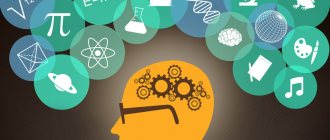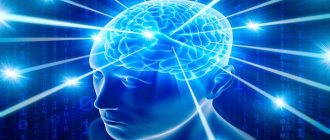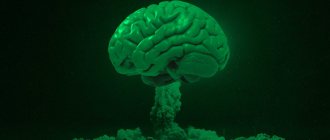Stages of development of self-awareness, its structure and functions
The stages of the formation of self-awareness coincide with the stages of a child’s mental development - the formation of his intellectual and personal spheres, which unfold from birth to adolescence inclusive.
The first stage is associated with the formation of a body diagram in the baby - a subjective image of the relative position of the state of movement of body parts in space. This image is formed on the basis of information about the position of the body and its parts in space (proprioceptive information and the state of movement of organs (kinesthetic information). The body diagram extends beyond the physical body and may include objects that have been in touch with it for a long time (clothing) The sensations that arise in a child on the basis of proprioceptive and kinesthetic information create in him an emotionally charged impression of comfort or discomfort, i.e. what can be called the body’s well-being.Thus, the body diagram is initially the first component in the structure of self-consciousness.
The next step in the formation of self-awareness is the beginning of walking. At the same time, it is not so much the technique of mastery that is important, but rather the changes in the child’s relationships with the people around him. The relative autonomy of the child in his movement gives rise to some independence of the child in relation to other people. The child’s first idea of his “I” is associated with the awareness of this objective fact. S.L. Rubinstein emphasized that there is no “I” outside of the relationship to “YOU.”
The next stage in the development of self-awareness is associated with the child’s gender-role identity, i.e. identifying oneself as a gender and awareness of the content of the gender role. The leading mechanism for acquiring a gender role is identification, i.e. likening oneself in the form of experiences and actions to another person.
An important stage in the development of self-awareness is the child’s mastery of speech. The emergence of speech changes the nature of the relationship between a child and an adult. By mastering speech, the child gains the opportunity to direct the actions of other people at will, that is, from the state of an object of influence from others, he moves into the state of a subject of his influence on them.
About the structure of self-awareness
In the structure of self-consciousness it is customary to distinguish: “I” - the real, i.e. a set of ideas about oneself in the present, “I”-ideal – i.e. what I would like to be in general, “I” is the past, i.e. a set of ideas about one’s past “I”, “I”-future, i.e. a set of ideas about oneself in the future.
About the function of self-awareness
The leading function of self-awareness is the self-regulation of individual behavior. It is the totality of ideas about oneself and the assessment of these ideas that represents the psychological basis of an individual’s behavior. A person can only allow himself to behave as much as he knows himself. This formula largely determines the self-sufficiency of the individual, the degree of self-confidence, independence from others, freedom in behavior and awareness of the limitations of this freedom.
Also read:
Forensic psychiatric assessment of disorders of consciousness (D.R. Lunts, Ya.I. Morozov, N.I. Felinskaya) Organization of testing and assessment in teaching psychology Theory of activity: actions and goals, operations, psychophysiological functions Psychological theory of activity (part 2) : motivational and personal aspects of activity, needs, motives, special activities. Psychological theory of activity (part 3): motives and consciousness; motives and personality; development of motives, internal activity, activity and
Self-esteem in psychology
Almost his entire life is based on a person’s self-esteem. No other topic in the science of psychology is as important and fundamental. Self-esteem stems from self-awareness.
Self-esteem is the assessment of oneself. Accordingly, everything depends on how a person perceives HIMSELF, how he managed to know himself.
When a person has low self-esteem, he cannot adequately evaluate himself and his abilities. As soon as they make a comment to him about his appearance or the work done, he will immediately take it personally as a negative assessment.
It's all about a person's inability to sensibly evaluate himself. Regardless of age, he is used to relying on other people's opinions. Since childhood, he has been asking: did I do the right thing? Does my hair look good? Is that what I said or not?
And if he has completed the work, then he will certainly need someone “superior” to definitely confirm that everything is fine.
He always needs confirmation of the correctness of his action.
The reason for this behavior is lack of self-confidence. Lack of personal experience, internal base, foundation. Such an internal basis is formed in a person when he has the experience of success. When he trusted himself, and everything worked out for him. When a person listened to his voice, to his own opinion, and the deal was a success! When he became pleased with his hairstyle in the mirror, for some reason his colleagues noticed it and complimented him!
Structural elements of self-awareness
In modern psychology, there is a variety of approaches and techniques in determining the structure of self-consciousness and its components. In this case, the following elements are traditionally distinguished:
Cognitive, also defined as reflexive and rational, reflects a person’s ideas about himself and is a process of self-knowledge, the results of which are expressed in various images of “I”.
In the system of self-awareness of an individual there is a large variety of alternating perceptions of one’s “I”. Usually distinguished:
- “I am real” - an objective idea of oneself in the present tense;
- “Ideal self” is the image that a person would like to correspond to;
- “fantastic self” - a person’s unrealizable dreams of what he would like to become.
- “mirror self” - a person’s ideas about how others see him.
Emotional-value is a component that includes a person’s value attitude towards himself and his self-esteem. The emotional-value element is understood as the experience of one’s success or failure in life, in accepting or rejecting oneself, a feeling of self-confidence or uncertainty, etc.
An individual’s self-esteem is based on comparing himself with the people around him, as a result of which he analyzes the aspects of his “I”. When evaluating himself and others, a person relies on a value system that he uses as a standard.
Self-esteem is characterized by three parameters:
- in level it can be high, medium or low;
- according to reality, it can be overestimated or underestimated;
- according to the structural features - conflict and conflict-free.
Self-attitude is also built on the basis of comparison, but in this case it is carried out through internal dialogue with oneself. In psychology, three aspects of the structure of self-attitude are defined:
- self-esteem - an internally justified or evaluative positive attitude towards oneself;
- autosympathy - non-judgmental positive and negative self-attitude;
- Self-deprecation is a negative self-perception.
The main difference between self-esteem and self-attitude is that the first is based on an external evaluative basis in the form of other people and certain values, and the second is based on an internal basis in the form of oneself.
Self-actualization is the most important element in the process of personality formation, which determines its psychological development and awareness of its purpose in life.
Relying on his internal motives and needs, a person strives for the maximum realization of his potential and abilities. A person’s self-actualization directly affects his level of self-esteem and attitude towards himself.
In Maslow's system of basic needs, self-actualization is based on 8 characteristics:
- life “here and now”;
- openness to the new and unknown;
- do what you like;
- be honest with yourself and others, take responsibility for your actions;
- trust your opinion even if it does not coincide with the views of the majority;
- constantly engage in self-development;
- to be reborn, to rethink your values and views.
- develop conscious behavior.
The level of aspiration is the individual’s desire to achieve goals of such a level of complexity that would correspond to his abilities. It depends on the success or failure of a person in any field of activity: the more successful the result, the higher the level of aspirations and, on the contrary, in the case of a negative or insufficiently successful result, it decreases.
People with a level of aspiration that matches their real capabilities are usually more successful and confident in their abilities.
Levels
Knowledge about oneself presupposes the formation in a person of a self-concept - a stable system of ideas about oneself. It is a product of self-awareness. In the self-concept, three levels can be distinguished, they are also called levels of self-awareness:
- cognitive – a person’s ideas about himself as a person, individuality, knowledge and acceptance of all his characteristics;
- evaluative – a sense of self-worth, self-worth, including a person’s awareness of the significance and value of his profession, external features, character;
- behavioral – behavioral attitudes and a person’s attitude towards his own personality.
Moral self-awareness of the individual
Personal self-awareness in psychology is presented in the works of a large number of foreign and domestic psychologists. Analysis of theoretical works allows us to formulate the moral self-awareness of the individual. It manifests itself in the process of regulation and awareness by a person of his actions, thoughts and feelings. As a result, there is a correlation between one’s moral character and the moral values and requirements of society.
The moral self-awareness of an individual is a complex system in which it is customary to distinguish two levels that are not supposed to be opposed to each other. These are the everyday and theoretical levels.
The everyday level can be depicted as an assessment of moral standards, which is based on everyday relationships between people. This level depends on the customs and traditions accepted in society. Here simple inferences arise that are associated with assessments and observations.
And the theoretical level, in turn, is based on moral concepts that help to understand the essence of moral problems. It provides an opportunity to understand ongoing events. There are such structural components as: values, meanings and ideals. They connect the moral self-awareness of an individual with human behavior.
The most important forms of moral self-awareness of an individual are considered to be shame, duty, conscience and responsibility, retribution and obligation. In this case, shame acts as an elementary form, and conscience is universal. Other forms of moral consciousness are highly differentiated.
Shame provides the individual with the opportunity to act in accordance with the dictates of culture and the moral ideals of society. Conscience is a person’s experience of his own dignity and the correctness of his actions. Duty is an internal requirement that requires a person to act in accordance with his moral standards. Responsibility confronts a person with the task of choosing some motive, need, idea or desire. Retribution involves understanding the connection that exists between the praiseworthy reaction of others to a worthy action and the opposite reaction to an immoral action. Duty has a similar meaning to the concept of responsibility and contains three components: awareness, respect and internal compulsion to fulfill moral requirements.
We are on Telegram! Subscribe and be the first to know about new publications!
Individual development
Self-awareness is not a high-quality trait at birth. It lasts for an unlimited period and improves constantly.
In general, a person’s self-awareness in psychology occurs through a specific number of alternating events, which can be symbolically divided into the following stages:
- Up to one year - the baby is separated from the world of people and objects. The child distinguishes himself and separates himself from others, but does not understand the personal characteristics of those who are dear to him. Games occur that demonstrate the leading difference between the baby's active and passive self-meaning. This experience gives the child the opportunity to realize his individual potential. The emergence and composition of children's speech has a special meaning. This literally brings him into the realm of relationships with the people around him.
- 1−3 years - characterized by intense and necessary emotional development. The child’s self-identification is associated with motivations for ideal actions and their coordination in time. Opposition to others is often unfavorable. It is precisely on this basis, without paying attention to the imperfection and inconstancy of data on the first forms of motivation, that the definition of the spiritual Self occurs.
- 3−7 years - development and understanding occurs evenly. At the 3rd year of life, the baby stops talking about himself in the 3rd person, wants to experience his own freedom and contrast with others. These efforts to gain personal freedom lead to a number of conflicts.
- 7−12 years - reserves continue to accumulate, and the process of self-awareness proceeds without significant regression or leaps. Very important changes in consciousness associated with changes in social criteria (for example, schools) are noted.
- 12-14 years - the child again begins to show attention to his own personality. New progress develops when it strives to stand out and oppose itself to maturity. Public awareness is clearly expressed.
- 14-18 years old is of particular importance; the personality rises to a new level, and this has an immeasurable impact on the further development of self-awareness. Reason, the collection of knowledge about one’s personality are the main value. This is the beginning of maturity.
SELF-AWARENESS
a person’s understanding of his personal qualities and himself as part of the objective world, his role in its development and place in it.
one of the aspects of human consciousness, his awareness of himself as an individual, his feelings, desires, needs, ideals, advantages and disadvantages.
a person’s understanding of his personal qualities and himself as part of the objective world, his role in its development and place in it..
acts as a mechanism that ensures monitoring of the dependence of the dynamics of the content of the image of “I” on the content of the fixed image of “I”, placed in a reflexive position.
a person’s awareness and assessment of himself as a subject of practical and cognitive activity, as an individual (i.e., his moral character and interests, values, ideals and motives of behavior).
a person's awareness and assessment of himself as a practical subject. and knowledgeable. activities as a person (i.e., one’s moral character and interests, values, ideals and motives of behavior). WITH.
characteristic not only of the individual, but also of society, class, social group, nation, when they rise to an understanding of their position in the system of societies, relationships, their common interests and ideals. In S.
a person distinguishes himself from the entire surrounding world, determines his place in the cycle of natural and social events, events. S. is closely related to reflection, where it reaches the theoretical level. thinking.
Since the measure and starting point of a person’s relationship to himself are, first of all, other people, S. by its very essence has a social character. See Art. Consciousness and lit. To her.
isolating one’s “I” from the objective world in a person’s consciousness, understanding one’s place in the world, one’s strengths and weaknesses, introspection of one’s states and experiences, self-assessment of personal qualities and self-regulation of behavior.
Only a person has self-awareness, as a vision of his originality, his individuality and difference from others of his own kind. Self-awareness is always spiritual; ideas of freedom and self-respect arise in it. It gives rise to human personality.
They reveal the historical memory of the main stages of the development of the community, and then we are dealing with citizenship, patriotism, pride, and respect for the history of our people.
awareness, a person’s assessment of himself as a subject of practical and cognitive activity, as an individual (i.e., his moral character and interests, values, ideals and motives of behavior). WITH.
characteristic not only of the individual, but also of society, class, social group, nation, when they rise to an understanding of their position in the system of social relations, their common interests and ideals. In S.
a person distinguishes himself from the entire surrounding world, determines his place in the cycle of natural and social events. S. is closely related to reflection, where it reaches the level of theoretical thinking. Since the measure and starting point of a person’s attitude towards himself are, first of all, other people, S.
is essentially social in nature. A teacher’s professional self-esteem is made up of his ideas about how he is assessed as a professional by students, colleagues, management, parents, and other people who are reference points for the teacher.
Fundamentals of Consciousness
During adolescence and adolescence, the foundations of self-awareness accumulate. It is precisely this stage (from eleven to 20 years) that includes the impact on a person of his own status among peers, an assessment of the philosophy of social thinking, his work and the correspondence of the real “I” with the perfect one. The defining categories for the formation of self-identification are considered to be the consciousness of the world and the subject.
Awareness is a system of a person’s holistic judgments about himself , about reality, current situations and the actions of people. The individual relies on the abilities and knowledge acquired by a certain period and does the work deliberately. Self-affirmation and self-improvement are human behavior that is justified by increasing self-esteem and maintaining a desired social status. The method depends on the education, capabilities and personal characteristics of a particular person. An individual can speak about himself either through personal achievements or in another way.
Other significant categories may include:
- awareness of the irreversibility of time and the meaning of life;
- formation of self-esteem;
- own understanding of intimate sensitivity (but there are also gender differences due to the fact that girls actually develop physiologically faster than boys). There is an awareness of love as a psychological expression.
Along with these categories, it is necessary to identify the social role and social status as the main nuances of the formation of self-awareness. This is considered a mandatory feature of behavior, expressed in the implementation of actions that correspond to recognized standards and one’s own expectations. The individual may begin to connect his judgments with the actual performance of the role.
This has a strong impact on personality composition, for example, how social interaction can significantly help a person adjust to life. Social status is a position that includes a number of rights and obligations. Some may be called high names at birth, while others consciously reach heights throughout their lives.
The structure of the self-concept
At the same time, if we consider the product of self-consciousness - images of the Self, we can distinguish:
- I am real (as I am now);
- I am ideal (what I can become in accordance with my capabilities);
- I am fantastic (what I could become if it were possible).
The contradiction between the ideal self and the real self can serve as both an impetus for self-development and cause personality disharmony. It is worth noting that self-awareness is a dynamic structure. She is prone to changes and transformations of self-images.
In some theories there is a broader classification of self-images. Stands out:
- I am real;
- I am the ideal;
- Self-potential;
- I am personal;
- I-activity (professional, non-professional).
In other works, for example, Sh. Samuel, you can find the concept:
- I-bodily;
- I-real (present, actual);
- Self-dynamic;
- I-fantastic;
- I-probable;
- I-idealized;
- I-represented;
- I-ideal;
- Future (possible) self.
I am corporeal
Each person has a sense of his own body, which may differ from what is shown in the mirror. This refers to signals sent to the brain about the location of body parts, their shape and length. Within the framework of the I-bodily, we can additionally distinguish:
- real perception in terms of subjective functionality;
- internal factors caused by personal experiences or difficult situations;
- social factors, that is, environmental reactions and the interpretation of these reactions by the individual;
- the ideal body image as a result of the combination of all factors, comparison and a person’s perception of his body.
Real Me
The totality of a person’s ideas about himself at a given moment in time (as he seems to himself). However, this idea does not necessarily correspond to objective reality. The present self provides flexibility in reactions in response to changing environmental conditions. It allows you to choose personal goals, behavioral strategies, claims, and more.
Self-dynamic
Reflects the personality’s ideas about it, but in projection, that is, about what a person wants to become (goal). Depends on a person’s social status, opportunities and successes. The dynamic self is prone to changes, which are influenced by the successes and failures of the individual, identification with significant and ideal (in the person’s mind) people, ideas about desired roles and status.
I'm fantastic
Essentially, these are a person’s dreams, ideas about what he would be like if everything were possible. As a rule, this component exists only until adolescence, and as a person grows older, it begins to actively collapse.
I'm perfect
A person’s ideas about what he should become, based on the learned norms and values of society. Depends on the moral development of the individual, moral maturity and socialization. It is formed in the process of a person’s identification with people (heroes) whom he admires.
If the ideal self does not transform into the dynamic, and then into the present, then, most likely, it will disintegrate completely. This is dangerous with disappointment and frustration.
I am possible (future)
A person's ideas about what he can become. Most often it differs from the ideal self. It is formed on the basis of a person’s real position, real status, opportunities and role.
Idealized self
A person’s ideas about what he would like to be right now, how he would like to see himself. This is an incoming component that depends on the specific situation.
Self-represented
Images created and exhibited by a person specifically for display in order to hide undesirable (negative in his opinion) traits, qualities of the present self. The represented self plays the role of protection and adaptation.
Most often, the imagined Self is close to the ideal Self, but if these components differ and do not come close, then problems arise in a person’s relationships, and later the person is subject to disappointment and frustration. A sign of such inconsistency and incipient frustration is embarrassment.
I'm fake
It represents a distorted “I-real”, that is, self-deception of the individual. With frequent reproduction of false but desirable personality traits:
- afraid of negative self-esteem;
- expects negative attitude from outside;
- incapable of actions that nurture self-respect.
From the false self, many protective mechanisms of the personality are activated, which ultimately acquire a pathological character. All self-knowledge is distorted, and then the knowledge and perception of interpersonal relationships.
Formation of individuality
Each person is unique in their own way. He appears simultaneously from several positions, being an individual, a personality and a subject of activity. However, this does not mean that everyone will be able to achieve a harmonious interaction of all properties, qualities, and methods of activity throughout their life. In other words, not all people are capable of becoming individuals.
Indeed, self-awareness and personality development occur differently for everyone. At the same time, not every person is able to fully use their potential capabilities, achieving the highest results in a particular activity. The individual’s professional self-awareness also suffers from this. In this case, a person’s work becomes unproductive and uncreative.
To develop individuality, you will need to make enormous internal efforts. And here you can’t do without self-awareness. The formation of personality occurs under the influence of events occurring around it and emerging experiences. But it is worth noting that these tests benefit the individual. Without difficult situations and experiences, her development would have stopped immediately.
The life of any person proceeds in such a way that he, voluntarily or involuntarily, learns new things, and also makes some efforts to realize his dreams and plans. And self-awareness plays a major role in this.
As a rule, individuality does not come cheap for anyone. People are forced to defend it in front of loved ones and colleagues, who sometimes simply do not understand the desires that have arisen. Building your own image, unlike anyone else, allows you to form the “I-concept” of a person’s self-awareness. It determines what a person will become in the future, and also thanks to what he will achieve his goals. And all this is greatly influenced by the level of self-awareness.
Self-awareness and self-esteem of the individual
The stimulus for personal development is self-esteem. It is an emotionally charged assessment of the image of “I”, which consists of the subject’s concepts about his activities, actions, his own strengths and weaknesses. In the process of socialization of a person, the ability to self-esteem is formed. This happens gradually, as a personal attitude to actions is revealed, based on the assessments of others and the assimilation of moral principles developed by society.
Self-esteem is divided into adequate, underestimated and overestimated. People with different types of self-esteem in the same situations can behave completely differently. They will influence the development of events in every possible way, taking radically opposite actions.
Inflated self-esteem occurs in people with an idealized idea of their importance to others and the importance of personality and value. Such a person is filled with pride and pride, and therefore never admits his own knowledge gaps, mistakes or unacceptable behavior
He is lazy and often becomes aggressive and tough.
Very low self-esteem is characterized by shyness, lack of self-confidence, shyness and failure to realize one’s talents and skills. Such people are usually overly critical of themselves and set goals lower than those they could achieve. They exaggerate personal failures and cannot do without the support of others.
Active, energetic and optimistic people develop adequate self-esteem. She is distinguished by a reasonable perception of her own abilities and capabilities, a rational attitude towards failures about the appropriate level of aspirations.
For self-esteem, self-esteem also plays an important role, that is, a personal opinion about oneself, regardless of the opinions of other people, and the level of a person’s competence in a strong area.
Awareness of one's self in psychology
A person’s awareness of his “I” occurs from childhood. It all starts with the child observing the behavior pattern of his parents or environment. Contemplation smoothly turns into repetition of actions, and a little later the child understands himself as an individual. He, little by little, begins to form a value-based attitude towards himself, that is, his self-esteem is formed.
It is important to note that with the process of growing up, a person’s attitude towards himself changes. Changes occur in the assessment of the actions of other people, comparison with those images that have already been formed before. Not only actions are taken into account, but also experiences, desires, and aspirations.
A person feels who he really is and what distinguishes him from other people. We can say that a person’s awareness of his “I” is the result of his development, and not innate data. It is our mind that analyzes and draws conclusions. This means that the environment and everything that comes into a person’s gaze, the events that happen to him, influence the formation of his self-esteem.
Self-perception while performing actions, understanding what you like or don’t like - this is awareness of your “I”.
Stages of development
The self-awareness of an individual is formed simultaneously with the mental development of the child, when the formation of his individual and intellectual spheres occurs. A similar process covers the time practically from the very birth of a person to adolescence and continues further.
The formation of a person’s self-awareness at the first stage is associated with the formation of a body diagram in a little person. It is a kind of subjective image that indicates to the child the relative position of the parts of the body and their movement in space. The formation of such an idea occurs on the basis of the information that children receive as they gain life experience. Subsequently, the body diagram gradually begins to extend beyond its physical forms. Over time, it includes, for example, objects that are in direct contact with the skin (clothing). All the sensations that arise in a child create in him various emotions associated with the well-being of the body. This may be an impression of comfort or discomfort. Thus, the body diagram becomes the first component in the structure of a person’s self-awareness.
The second stage of the formation of the concept of one’s own “I” starts simultaneously with the start of walking. At the same time, what is important for the child is not so much the technique of movements that are new to him, but the opportunity he now has to communicate with different people. The baby becomes independent from who will lead him and who will approach him. All this leads to the emergence of self-confidence, as well as to an understanding of where the boundaries of freedom end for him. The self-awareness of the individual at this stage is expressed in some independence of the baby in relation to the people around him. Awareness of such a subjective fact gives the child the first idea of his “I”, which does not exist outside of the “You” relationship.
The next stage in the formation of a person’s self-awareness is the development of a child’s gender-role identity. This is expressed in the fact that the child begins to identify himself as a certain gender and is aware of the content of the gender role. The leading mechanism of such a process is identification. Children liken themselves to another person in the form of their inherent actions and experiences.
The most important stage in the development of self-awareness and personality formation is the child’s mastery of speech. Its occurrence significantly changes the nature of the relationships that develop between a little person and adults. A child who has mastered speech is able to direct the actions of nearby people at will. In other words, his position as an object of influence from others changes to the state of the subject influencing them.
Between the ages of 3 and 7 years, the development of self-awareness occurs evenly and smoothly. At the beginning of this period, children stop talking about themselves in the third person. This is explained by the desire to experience some independence, as well as to contrast oneself with others. Such individual aspirations for independence lead to periodic conflicts with others.
The growth of self-awareness and personality development continues in the period from 7 to 12 years. This is the time when the child accumulates reserves. The process of increasing self-awareness occurs without noticeable leaps and crises. At this age, significant changes in the understanding of the world are noted only in connection with the emergence of new social conditions, when a small person becomes a schoolchild.
The child begins to be interested in his own personality again from 12 to 14 years old. During this period, a new crisis develops. The child opposes himself to adults and strives to be different from them. During this period, social self-awareness is especially clearly expressed.
Of particular importance in the formation of a person’s inner “I” is the period of his life from 14 to 18 years. This is where individuality rises and moves to a new level. At the same time, the person himself begins to influence the further development of all characteristics of the individual’s self-awareness. This stage indicates the beginning of maturity.
You may also be interested
.
Concepts and states
Types and forms
Social control - what is it, types
The basis of self-awareness is internal sensitivity - synesthesia. It is realized in the form of a feeling of freedom, confidence and well-being. Psychologists distinguish several types of self-awareness.
With a clear consciousness, a person adequately evaluates himself, he has good reactions and orientation in space
When consciousness becomes clouded, the individual begins to lose interest in the world, becomes indifferent and does not respond to questions. He does everything leisurely, all his reactions are slow.
Important! Blurring may be a sign of life-threatening conditions.
There is also such a type of self-awareness as stupor. It is characterized by numbness, drowsiness, and very poor spatial orientation. In this state, speech is unintelligible, the person’s movements become slow.
In a coma, the individual is not aware of himself, does not respond to stimuli and is in an apathetic state. Even if he wakes up, he will have to undergo a long rehabilitation course.
Self-awareness involves more than just individuality. It comes in several forms. Social means the spiritual life of society. It includes traditions, customs, and morals. By ordinary we mean everyday life and solving typical situations: how to arrange everyday life, division of responsibilities, etc.
Self-awareness includes mass consciousness. Through this form, the life of certain social groups is considered: social and political. Particularly interesting is the influence of the opinions of leaders and the media on individual people.
There are also three types of self-awareness. Social - allows an individual to understand how to behave in a team, historical - allows one to take into account the experience of previous generations, political - makes it possible to track changes in the world.











